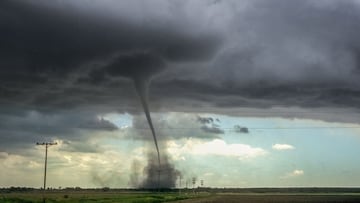What should you do if a Severe Thunderstorm Warning is posted? Safety precautions
Last year, the National Weather Service (NWS) made changes to its Severe Thunderstorm Warnings. Here’s what you need to know.

In August 2021, the National Weather Service (NWS) made changes to its warning system regarding severe weather and more specifically, thunderstorms. ‘Severe thunderstorms’ range widely in terms of the risk they pose to life and the damage they can cause.
Related stories
- Tips to stay cool when the temperature rises
- NASA shows historic change in the largest reservoir in the US
- Housing market recession?
According to the NWS, a severe thunderstorm is defined as one which: produces a tornado, winds of at least 58 mph (50 knots or ~93 km/h), and/or hail at least 1″ in diameter. Structural wind damage may imply the occurrence of a severe thunderstorm. A thunderstorm wind equal to or greater than 40 mph (35 knots or ~64 km/h) and/or hail of at least ½” is defined as approaching severe.
But that is too broad a description for issuing warnings, which is why last year, the NSW decided to break severe thunderstorm warnings into three separate categories to inform the public about the threat they pose and what action to take. Now, severe thunderstorm warnings, in order from the greatest possibility of damage to the least are: Destructive, Considerable and Base - rated in terms of the physical damage they could cause.
An uptrend in thunderstorm activity begins today and continues through the upcoming week. There remains an elevated threat of flash flooding; consequently, a Flood Watch has been issued and continues through Wednesday morning for the highlighted counties. #AZwx pic.twitter.com/BByqTQTekX
— NWS Phoenix (@NWSPhoenix) July 24, 2022
What is the difference between a Watch and a Warning?
When severe weather is forecast, the NSW will issue a Severe Thunderstorm or Tornado Watch. A watch differs from a warning in that it advises the public to be prepared for a storm, although the exact time and location of storm development will not be specified or known. They are usually issued for a duration of 4 to 8 hours - well in advance of the moment when a storm could strike.
Destructive damage threat: At least 2.75-inch diameter (baseball-sized) hail and/or 80-plus-mph thunderstorm winds. Warnings in this category will automatically activate a activate a wireless emergency alert, or WEA, to your mobile phone within the danger zone.
Considerable damage threat: At least 1.75-inch diameter (golf ball-sized) hail and/or 70-plus-mph thunderstorm winds. These warnings will not activate a WEA.
Base Severe Thunderstorm Warning: At least 1-inch diameter (quarter-sized) hail and/or 58-plus-mph thunderstorm winds. These warnings will not activate a WEA. When no damage threat tag is present in the warning, damage is expected to be at this base level.
7/22 2pm EDT - Good news! It looks quiet this weekend for the Atlantic basin. Always best to check https://t.co/tW4KeFW0gB daily to see if there are any changes though. pic.twitter.com/TmbwIP2ii7
— National Hurricane Center (@NHC_Atlantic) July 22, 2022
Safety precautions
The best safety advice is to make sure you are fully prepared for the worst case scenario. When a watch is issued, keep yourself informed about the storm’s development and projected path - a watch area is typically large, covering numerous counties or even states. Have a contingency plan and an emergency kit (water, non-perishable food, medication) prepared. If you have children, make sure they know and understand what a tornado is, what tornado watches and warnings are, what county or parish they live in (warnings are typically issued by county or parish), and where they can find a safe shelter quickly, whether at home or at school.
Related stories
When warnings indicate imminent danger to life and property, take shelter somewhere where you are protected - a tornado shelter, basement or inside room without windows on the lowest floor (bathroom, closet, center hallway). Avoid sheltering in any room with windows. Make sure you have essential supplies - new, unused batteries - access to a battery-operated TV, radio, or internet-enabled device to follow weather updates and information. Weather updates can be found on the official government websites - https://www.weather.gov/ and the National Hurricane Center: https://www.nhc.noaa.gov/)
Keep a list of important information such as telephone numbers and contact details. If you are outside or in a mobile home, find a nearby building, preferably one which has a basement. If you are in a car, do not try to outrun a tornado, but instead find the nearest sturdy building and take shelter there.

